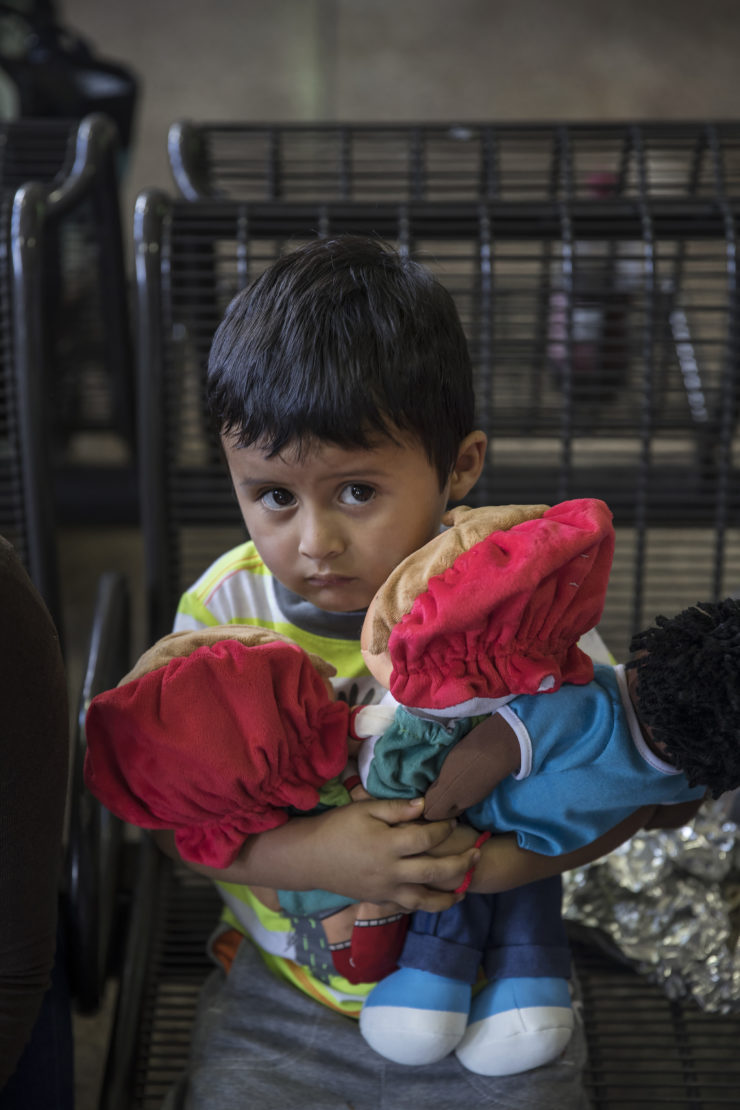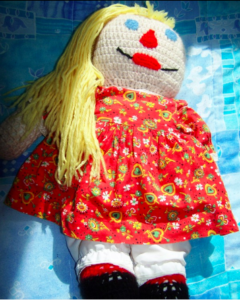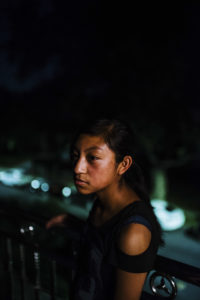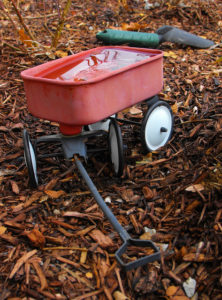
Adan Galicia Lopez, 3, who was separated from his mother for four months, in Phoenix, July 10, 2018. Under the Trump administration's “zero-tolerance” policy for border enforcement, thousands of children were sent to holding facilities, sometimes hundreds or thousands of miles from where their parents were being held for criminal prosecution.
America’s debate over immigration has played out to the recorded cries of children separated from their parents at the U.S.-Mexico border, to broadcast images of tears and hugs as some are reunited after weeks or months apart, to public protests demanding an end to the wrenching policy of family separation. Since a border crackdown ordered by the Trump administration in April, thousands of children – estimates topped 3,000 – were placed under government supervision while their parents were jailed or deported.
Trump called a temporary halt on family separations in June, and courts have ordered that families be reunited. But efforts have been hampered by politics, inconsistent interpretations of policy, and chaotic record-keeping. As of late July, an estimated 600 children remained in government custody, scattered to an array of facilities across the country.
Reports of conditions in those facilities – from vast holding centers to camplike settings, from repurposed shopping centers to military-style tent camps – have been largely controlled by the government or contract agencies running them. Recent news investigations have revealed desperate situations at some of them. Most information has come from carefully guided tours, painstaking public records requests or through second-hand accounts from immigration lawyers, activists or relatives who have been in phone contact with the sheltered children.
 A team from The New York Times reported beyond documents and official statements to glean a child’s-eye view of life inside the centers. “Cleaning Toilets, Following Rules: A Migrant Child’s Days in Detention,” published July 14, 2018, paints a portrait through first-person accounts of the children who spent time there. Reporters fanned across the country, working with immigration attorneys and advocates to find children who had recently been released from facilities; parents or guardians were present for the interviews but, as senior writer and columnist Dan Barry noted: “The descriptions and words are theirs, and were not funneled or interpreted through a third party.”
A team from The New York Times reported beyond documents and official statements to glean a child’s-eye view of life inside the centers. “Cleaning Toilets, Following Rules: A Migrant Child’s Days in Detention,” published July 14, 2018, paints a portrait through first-person accounts of the children who spent time there. Reporters fanned across the country, working with immigration attorneys and advocates to find children who had recently been released from facilities; parents or guardians were present for the interviews but, as senior writer and columnist Dan Barry noted: “The descriptions and words are theirs, and were not funneled or interpreted through a third party.”
As lead writer, Barry worked with editors Kim Murphy and Marc Lacey to craft an intimate narrative based on primary field reporting from Miriam Jordan, Annie Correal and Manny Fernandez, with Kayla Cockrel, Caitlin Dickerson, Michael LaForgia and Liz Robbins also contributing.
I wanted to put this through the eyes of children. ~ Dan Barry
The tangle of past and future immigration policy will continue to enmesh politicians, courts, lawyers, activists and the engaged public. Stories focusing on those controversial policies will inevitably shape the treatment of those who show up at American borders. That intensifies the imperative of political, investigative and best reporters to inform the public the what and why of events, and to put their reporting in context.
But it also creates powerful opportunities – and pressures – for narrative storytellers, whose job is to reveal personal experience through sights, sounds and emotion while standing on the foundations of ethical, transparent, credible reporting.
We start with an editor’s overview of how the story was conceived, reported, verified and written. Below that is an annotation of the full story based on an interview with Dan Barry.
The annotation: Storyboard’s questions are in red; Dan Barry’s responses in blue. To read the story without annotations, click the ‘Hide all annotations’ button, which you’ll find just below the social media buttons in the top right-hand menu or at the top of your mobile screen.
Cleaning Toilets, Following Rules: A Migrant Child’s Days in Detention
A portrait of life in the shelters for the children detained after crossing the U.S.-Mexico border.
By Dan Barry, Miriam Jordan, Annie Correal and Manny Fernandez
The New York Times
July 14, 2018
Do not misbehave. Do not sit on the floor. Do not share your food. Do not use nicknames. Also, it is best not to cry. Doing so might hurt your case.Lights out by 9 p.m. and lights on at dawn, after which make your bed according to the step-by-step instructions posted on the wall. Wash and mop the bathroom, scrubbing the sinks and toilets. Then it is time to form a line for the walk to breakfast.
“You had to get in line for everything,” recalled Leticia, a girl from Guatemala.
You begin with a listing of the rules of the shelter, as if you are talking to one of the children there. Why did you decide to use that technique? One, there was the approaching panic of deadline and that can clarify the mind. I had to figure out some universal opening and lead the reader into specifics and I thought that using short sentences and putting everything in the negative would set the tone. The negatives define the child’s experience of what they can do. I wanted to put this through the eyes of children. I wanted it in simple language, told with innocence through the eyes of that 10, 11, 12, 13-year old boy or girl. That provided the narrative thread that we sought.Small, slight and with long black hair, Leticia was separated from her mother after they illegally crossed the border in late May. She was sent to a shelter in South Texas — one of more than 100 government-contracted detention facilities for migrant children around the country that are a rough blend of boarding school, day care center and medium security lockup. They are reserved for the likes of Leticia, 12, and her brother, Walter, 10.
The facility’s list of no-no’s also included this: Do not touch another child, even if that child is your hermanito or hermanita — your little brother or sister.
Leticia had hoped to give her little brother a reassuring hug. But “they told me I couldn’t touch him,” she recalled.
In response to an international outcry, President Trump recently issued an executive order to end his administration’s practice, first widely put into effect in May, of forcibly removing children from migrant parents who had entered the country illegally. Under that “zero-tolerance” policy for border enforcement, thousands of children were sent to holding facilities, sometimes hundreds or thousands of miles from where their parents were being held for criminal prosecution.
How did the piece come together? I work across the newsroom, in sports and metro, and I do a lot for national (desk). National editor Marc Lacey asked me to help. A lot had been written about these detention centers. The New York Times has the luxury of having reporters and correspondents around the country. So we were wondering how do we tell one story with our access. Miriam (Jordan), Annie (Correal) and Manny (Fernandez) were all sent out. They did a lot of talking to lawyers and convincing them to get children to talk. They did an extraordinary job in finding them. My job was to discuss with all the reporters what we were looking for — to put the reader inside these facilities. Then, as their memos came in, my job was to figure out how to tell a narrative for which there was no specific dateline, since the reports were from all over the country. I was looking for the connective tissues, the similarities, the links — the way “in.”Last week, in trying to comply with a court order, the government returned slightly more than half of the 103 children under the age of 5 to their migrant parents.
But more than 2,800 children — some of them separated from their parents, some of them classified at the border as “unaccompanied minors” — remain in these facilities, where the environments range from impersonally austere to nearly bucolic, save for the fact that the children are formidably discouraged from leaving and their parents or guardians are nowhere in sight.
Depending on several variables, including happenstance, a child might be sent to a 33-acre youth shelter in Yonkers that features picnic tables, sports fields and even an outdoor pool. “Like summer camp,” said Representative Eliot L. Engel, a Democrat of New York who recently visited the campus.
“Like summer camp.” ~ U.S. Rep. Eliot L. Engel, D-New York
Or that child could wind up at a converted motel along a tired Tucson strip of discount stores, gas stations and budget motels. Recreation takes place in a grassless compound, and the old motel’s damaged swimming pool is covered up.
Still, some elements of these detention centers seem universally shared, whether they are in northern Illinois or South Texas. The multiple rules. The wake-up calls and the lights-out calls. The several hours of schooling every day, which might include a civics class in American history and laws, though not necessarily the ones that led to their incarceration.
Most of all, these facilities are united by a collective sense of aching uncertainty — scores of children gathered under a roof who have no idea when they will see their parents again.
In some of the description you use details from specific shelters – the Yonkers pool tables and sports fields – to explain the more general statement about calling these shelters “summer camp?” It’s the material we had and I didn’t want to begin with a specific facility. We were getting memos and trying to find what was common. We learned there was school, rules not to touch, rules about cleaning the bathrooms, and children cracking under pressure. The children are incredibly resilient and what bothered these children was the uncertainty if or when they saw their parents again.Leticia wrote letters from the shelter in South Texas to her mother, who was being held in Arizona, to tell her how much she missed her. She would quickly write these notes after she had finished her math worksheets, she said, so as not to violate yet another rule: No writing in your dorm room. No mail.
She kept the letters safe in a folder for the day when she and her mother would be reunited, though that still hasn’t happened. “I have a stack of them,” she said.
Another child asked her lawyer to post a letter to her detained mother, since she had not heard from her in the three weeks since they had been separated.
“Mommy, I love you and adore you and miss you so much,” the girl wrote in curvy block letters. And then she implored: “Please, Mom, communicate. Please, Mom. I hope that you’re OK and remember, you are the best thing in my life.”
You helped with writing the piece that brought together all the reporting? What were some of the things you thought about when doing so? They (writers and correspondents) filed their reports to deputy (national) editor Kim Murphy and we were looking for the unifying thought to support the narrative. The way I approached it was as much as possible through the eyes of the children, and not the advocates. What is it like for a boy or girl who finds himself or herself in one of these places?The complicated matters of immigration reform and border enforcement have vexed American presidents for at least two generations. The Trump administration entered the White House in 2017 with a pledge to end the problems, and for several months, it chose one of the harshest deterrents ever employed by a modern president: the separation of migrant children from their parents.
This is what a few of those children will remember.
No Touching, No Running
Diego Magalhães, a Brazilian boy with a mop of curly brown hair, spent 43 days in a Chicago facility after being separated from his mother, Sirley Paixao, when they crossed the border in late May. He did not cry, just as he had promised her when they parted. He was proud of this. He is 10.
He spent the first night on the floor of a processing center with other children, then boarded an airplane the next day. “I thought they were taking me to see my mother,” he said. He was wrong.
Once in Chicago, he was handed new clothes that he likened to a uniform: shirts, two pairs of shorts, a sweatsuit, boxers and some items for hygiene. He was then assigned to a room with three other boys, including Diogo, 9, and Leonardo, 10, both from Brazil.
The three became fast friends, going to class together, playing lots of soccer and earning “big brother” status for being good role models for younger children. They were rewarded the privilege of playing video games.
There were rules. You couldn’t touch others. You couldn’t run. You had to wake up at 6:30 on weekdays, with the staff making banging noises until you got out of bed.
“You had to clean the bathroom,” Diego said. “I scrubbed the bathroom. We had to remove the trash bag full of dirty toilet paper. Everyone had to do it.”
The theme of rules is a constant. Did this theme/thread strike you right away – is that what the reporters kept mentioning? When you are reading these accounts it is always important to get granular and to get specific details. Tl tell you: Here are the rules and their lives are regimented and they learn about American civics (in their classrooms) – and to make these examples as ground level as possible.Diego and the 15 other boys in their unit ate together. They had rice and beans, salami, some vegetables, the occasional pizza, and sometimes cake and ice cream. The burritos, he said, were bad.
Apart from worrying about when he would see his mother again, Diego said that he was not afraid, because he always behaved. He knew to watch for a staff member “who was not a good guy.” He had seen what happened to Adonias, a small boy from Guatemala who had fits and threw things around.
…it is always important to get granular and to get specific details… ~ Dan Barry
“They applied injections because he was very agitated,” Diego said. “He would destroy things.”
A person he described as “the doctor” injected Adonias in the middle of a class, Diego said. “He would fall asleep.”
Diego managed to stay calm, in part because he had promised his mother he would. Last week, a federal judge in Chicago ordered that Diego be reunited with his family. Before he left, he made time to say goodbye to Leonardo.
“We said ‘Ciao, good luck,” Diego recalled. “Have a good life.”
But because of the rules, the two boys did not hug.
Lessons in Math and Presidents

Yoselyn Bulux, 15, originally from Guatemala, who was separated from her mother at the border, in New York, July 5, 2018. Under the Trump administration's “zero-tolerance” policy for border enforcement, thousands of children were sent to holding facilities, sometimes hundreds or thousands of miles from where their parents were being held for criminal prosecution. “If you do something bad, they report you,” Yoselyn said. “And you have to stay longer.”
Yoselyn Bulux, 15, is a rail-thin girl from Totonicapán, Guatemala, with long dark hair and no clear memory of how she summoned the strength to climb the wall at the border. What followed was even harder: two days in a frigid processing center known as the “icebox,” then a two-day bus ride to a large facility somewhere in Texas. Her mother stayed behind in Arizona.
The new place had air-conditioning, but wasn’t as cold as the icebox, which had left her with a sore throat. There were windows, sunlight during the day. And beyond the perimeter, tall grass like the “zacate” you see along the highway.
At the intake area of the facility, which seemed to accommodate about 300 girls — some of them pregnant — she was given some clothes and a piece of paper with a number on it. There were rules.
“If you do something bad, they report you,” Yoselyn recalled. “And you have to stay longer.”
There are very personal details (child’s letter to her mother, an exchange with a boy who describes another child having fits and receiving injections). What was the verification process? This is an absolutely collective effort. Liz Robbins found that letter. There were attempts to corroborate information. Some of the facilities were more candid than others. We were confident in talking with the children. These kids had no reason to make up those kinds of details. Kids even admitted to the fact about not have good days all the time. We were confident that this is what happened.The days had structure. Yoselyn took classes with other teenage girls in math, language — she learned “good morning,” “good afternoon” and “good night” in English — and civics, which touched on, among other things, American presidents. President Trump was mentioned, she said.
For an hour every day, the girls went outside to exercise in the hot Texas air. It was not uncommon to see someone suddenly try to escape. No whispers, no planning — just an out-of-nowhere dash for the fence. No one made it.
“If you do something bad, they report you,” Yoselyn recalled. “And you have to stay longer.”
On Friday and Saturday nights, the girls watched movies. Also on Saturday, Yoselyn met with a counselor, whom she liked. They talked about her hope to be with her mother soon. She cried only twice.
But it wasn’t easy. Although Yoselyn spoke occasionally by telephone with her mother — the first time a full 10 days after their separation — the gossipy chatter among the girls could be confusing, and upsetting. “Some of the girls said we were going to get out,” she recalled. “Others said they were going to deport us.”
She made friends, and together they would paint their nails and make multicolored friendship bracelets out of yarn. She became especially close to a Guatemalan girl named Sofia. But one day, Sofia just disappeared.
Finally, on July 1, it was Yoselyn’s turn to leave. She was flown to New York on her first airplane flight. She watched the movie “Coco” while in the air. And then the woman serving as her escort handed Yoselyn over to her father, who was so overcome at the sight of his daughter that he could not speak.
A Birthday Passes
Victor Monroy did not understand. It was Sunday, June 24. His birthday. He was now, officially, 11.
But no one at this place where he and his younger sister had been sent seemed to know, or care. No one sang to him, the way his mother would have. Finally, Victor told the adults in this strange place of his personal milestone.
“They said ‘feliz cumpleaños,’” the boy recalled. “That’s all.”
Given all that was happening, the moment may seem small, even inconsequential. Then again, perhaps the quiet passing of his 11th birthday will, years from now, still evoke for Victor the 41 days he counted that he and his 9-year-old sister, Leidy, lived in a place called Casa Guadalupe, with no idea where their mother was for weeks.
…I remember being an 11-year-old boy and that chokes me up. ~ Dan Barry
“She’s the one who had been watching over me,” Victor said. “My whole life.”
In the story of Victor, who had a birthday, it talks about the lack of acknowledgement but also about how disconnected he is from his family. Why did you include the anecdote? Here is a boy who was 10 and it is his 11th birthday and no one cares and the workers give him an off-handed “happy birthday.” In the large context of things what the workers say is not the worst thing in the world. But I remember being an 11-year-old boy and that chokes me up. .. So wide-eyed, so vulnerable, so used to keeping my parents, especially my mother, within reach. And then trying to imagine that 11-year-old boy, a jumble of insecurity and wonder and goofiness, in one of these facilities, in a foreign country, separated from my parents.Victor and Leidy had left Guatemala with their mother by bus, but reached the United States border in the back of a tractor-trailer. Almost immediately, they were taken to a crowded place with other migrants. Then, late one night, agents started loading them into a vehicle, as their mother, who was being left behind in Arizona, quickly tried to explain what was happening.
Soon they were on their first airplane ride ever, on their way to some place called Chicago. They were taken to the shelter, given new clothes and separated: Victor to the boys’ area, Leidy to the girls’.
For the next several weeks, the only time the brown-haired siblings saw each other was during recreation period outdoors. If he asked, Victor said, he could spend up to a half-hour with Leidy.
“I didn’t want to go inside,” he said.
Their daily routine was similar to what thousands of migrant children were experiencing around the country. Early morning wake-up calls, chores, classes. Victor and Leidy didn’t speak to their mother for a month. Where was she? When would they get out? Only once, Victor’s frustration got the better of him.
 In the play area one day, some boys stole a ball that Victor was playing with, and he became distraught. When it came time to go back into the house, he refused. “I didn’t want to go inside,” he said.
In the play area one day, some boys stole a ball that Victor was playing with, and he became distraught. When it came time to go back into the house, he refused. “I didn’t want to go inside,” he said.
Then, Victor said, two men, including one named Tito, grabbed him by the arms and dragged him into the house. “I told him he didn’t have the right to do that,” the boy said. “And so he said, yes, he had the right to do whatever he wanted.”
Weeks later, Victor was still upset.
But at least he had a trabajadora de caso — a caseworker — named Linda who helped him navigate his new world. “She did everything she could to find my mother,” Victor said. “She called every state.”
Finally, there was a plan: Victor and Leidy would join their father, whom they hadn’t seen in a few years, in New England. The night before, Victor’s roommate and friend, a boy from El Salvador named Franklin, struggled to sleep.
“I don’t think he slept all night because I was leaving,” Victor said.
Sure enough, when the adults came for Victor in the morning, Franklin was awake to say goodbye.
“He wished me lots of luck,” Victor said.
Mischief and Melancholy
The kids are just — kids. That is what it comes down to, according to an employee at Casa Padre, a shelter for 1,500 migrant boys that inhabits a former Walmart Supercenter in Brownsville, Tex., close to the Mexican border. Just kids, all being held in the custody of the United States government.
Take the mooing, for example. The walls that separate the sleeping quarters do not reach the high ceilings, which means that sounds travel in the yawning spaces within the 250,000-square-foot building. One boy will make a loud animal noise, after which another will emit an animal-like response.
“Someone will start mooing,” the employee said. “They just think it’s funny. They just do it long enough so everyone can hear, and then we all start laughing.”
You ended the piece talking about the mooing. As a reader goes through the article, likely moved at how these children are kept isolated under strict rules then there is this chorus of mooing illustrating that at the end of the day they are just kids being kids. Why end this way? It’s a delicate thing. They’re not animals and we struggled with some of the imagery. We don’t want to say they are animals, but when Manny told me some are doing cows and donkeys, and you could just see a room full of children being detained and they have made friendships, and they get it that they shouldn’t be corralled – and yet they are wiseacres and trying to make their buddies laugh. What added to the power of that image in my head is that it was in an old Walmart superstore. Here are a bunch of children we are detaining and now these kids can’t leave and they amuse themselves as they are pent up. This is (their) distraction that allows them to set aside the reality and they are looking for a laugh.Casa Padre, which shares a parking lot with a gas station, a McDonald’s and other stores, is run by Southwest Key Programs, one of the largest migrant youth shelter operators in the country. According to the employee, its staff is overworked and a little stressed out by the 12-hour shifts and the considerable responsibilities.
A 15-year-old boy from Honduras recently escaped by climbing a fence during an outdoor recreation period. Staff members conduct round-the-clock head counts, sometimes at 15-minute intervals, all while monitoring the constant flow of boys being received and discharged.
The kids are just – kids.
During the day, the staff is required to maintain a ratio of one worker for every eight children. The ratio sets the tempo and culture at Casa Padre, the employee said. “It’s a big deal if we’re out of ratio.”
If one boy in a classroom needs to use the restroom, then a staff member has to find seven others who also want to go to the bathroom. “They’ll all stand in a line and then we’ll walk to the restroom,” the employee said.
Some of the boys at Casa Padre were separated from their parents at the border, but most were caught crossing without a parent or guardian. All seem to keep themselves entertained with soccer or movies or video games.
“If they get sad, it’s like a quiet thing,” the employee said. “You’ll see them sit on the floor and just kind of wrap their arms around themselves.”
Do you think the narrative style of this piece cuts through the noise a bit, or can make an impact that a straight news piece about family separations or reunifications can’t? That’s the power of narrative. It’s the power of trying to tap into the human condition with actual humans. If I told you they went to bed at 9 o’clock and if I tell you about Victor who had a birthday that wasn’t acknowledged and if I get names and granular details and the letters, the more grounded it is in the human condition. The more you and I can imagine ourselves being there. The information comes across as a punch to the nose instead of something abstract – and that’s the power of the narrative. You have a couple of paragraphs but them you give them Victor. You give them Leticia.Some time in the evening is set aside for prayer. Boys can be found praying in a classroom, in a game room, in a bedroom. Some kneel. After that, many focus on creating intricately designed bracelets out of the huge supply of colorful yarn that seems always available. The bracelets become gifts, keepsakes, something to remember someone by.
Lights out at 9. Then, depending on the night, a cavernous old Walmart in South Texas begins to echo with the sound of mischievous migrant children imitating the lows of pent-up cattle.
Reporting was contributed by Kayla Cockrel, Caitlin Dickerson, Michael LaForgia and Liz Robbins


